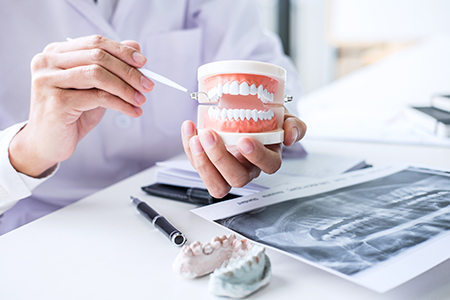Advances in materials, digital design, and clinical techniques have made removable dentures more comfortable and natural-looking than ever. While dental implants and fixed bridgework are excellent options for many people, removable dentures remain a reliable and versatile choice for restoring function and appearance when multiple teeth are missing. These appliances can rebuild a smile, support facial structure, and help people regain everyday confidence.
At Murphy Dentistry, we focus on personalized denture care that reflects each patient’s needs and goals. Our approach combines careful evaluation with modern fabrication methods so that the prosthesis we deliver supports proper chewing, clear speech, and a pleasing aesthetic. Every denture we make aims to balance comfort, durability, and a lifelike appearance.
Choosing the right denture involves more than selecting a tooth shade. We assess oral health, jaw relationships, and how the appliance will interact with the remaining teeth and soft tissues. That assessment guides both the technical design and the step-by-step process to achieve a predictable, long-lasting result.
Tooth loss affects more than the way a smile looks — it changes how the mouth works. Gaps alter biting force, which can make chewing less efficient and limit the foods a person can enjoy comfortably. Over time those altered forces can lead to extra wear on remaining teeth and uneven stress on the jaw joints and muscles.
When teeth are missing, the bone that once supported them tends to remodel and shrink. This gradual change in bone and soft-tissue contours can cause a sunken facial appearance, reduce lip support, and change the way dentures — or remaining teeth — fit. Replacing missing teeth helps preserve facial proportions and provides essential support for the lips and cheeks.
Beyond function and form, replacing teeth supports overall oral health. Properly designed dentures restore chewing efficiency, which helps people maintain balanced nutrition. They also reduce the tendency for adjacent teeth to drift into empty spaces, preserving alignment and making long-term dental care more manageable.

Dentures are removable prosthetic devices made to rest on the gums and replace missing teeth and surrounding tissues. They consist of artificial teeth set in a supportive base that is shaped to match the contours of the mouth. With current materials and techniques, dentures can be crafted to look natural and to harmonize with a patient’s facial features.
Unlike fixed solutions such as bridges or implant-retained crowns, removable dentures can be taken out for cleaning and overnight rest. That removability makes daily hygiene straightforward and allows clinicians to examine the gums and any remaining teeth during routine checkups. For many patients, this feature is an advantage for long-term oral maintenance.
Today’s denture workflows often incorporate digital impressions, precise bite records, and advanced tooth selection to create a prosthesis that balances appearance with reliable function. When stability is a concern, options such as attachments to natural teeth or implants can be discussed to improve retention while keeping the appliance removable.
Selecting a denture type begins with a thorough clinical evaluation. We examine the health and position of remaining teeth, measure how jaws relate to each other, and evaluate the gums and bone that will support the appliance. These elements determine whether a full arch replacement or a partial prosthesis is the most appropriate choice.
Complete dentures replace all the teeth in the upper arch, the lower arch, or both. Their design depends on the shape of the jaw, the available support from soft tissues, and the patient’s expectations for appearance and function. A well-crafted complete denture aims to restore proper lip and cheek support, establish a comfortable bite, and provide a lifelike smile.
A conventional complete denture is made after extractions and sufficient healing have occurred. Waiting for healing allows the soft tissues to stabilize, which can improve the accuracy of fit and long-term comfort. For patients who prefer to avoid a period without teeth, alternative approaches are available.
Immediate denture
An immediate denture is placed at the time teeth are removed so the patient leaves the appointment with a full set of teeth. Because the gums and bone change as they heal, immediate dentures often require adjustments or relining later to maintain fit and comfort.
Overdenture
An overdenture fits over remaining tooth roots that have been prepared for attachments or over carefully placed implants. Those anchors provide improved stability and make the prosthesis more secure during speaking and chewing.
Implant-supported dentures
Implant-supported dentures use a small number of strategically placed dental implants to anchor the denture. This connection substantially increases retention and reduces movement, while still allowing the appliance to be removed for cleaning when appropriate.
Partial dentures replace one or several missing teeth when other natural teeth remain. These appliances typically secure to adjacent teeth with clasps or precision attachments, restoring the visual continuity of the smile and improving chewing function without altering healthy teeth irreversibly.
Partial frameworks can be crafted from a variety of materials — including metal alloys, flexible resins, or hybrid systems — to suit a patient’s comfort and aesthetic preferences. Properly designed partials also help stabilize the bite, preventing unwanted tooth movement into the spaces left by missing teeth.
Regardless of the type chosen, successful denture therapy depends on careful planning, precise impressions, and a stepwise fitting process that accounts for function, speech, and facial appearance.

A predictable denture outcome begins with a detailed treatment plan. That plan reviews medical history, oral health, and the structural characteristics of the jaws and soft tissues. When needed, advanced imaging and digital scans help the team visualize bone shape and make informed decisions about support and retention.
Once a plan is set, impressions and bite records are captured to reproduce how the jaw closes and how teeth should relate to each other. Lab technicians use those records to create prototypes and try-in appliances that allow adjustments for tooth position, color, and overall balance before the final denture is finished.
Attention to each step — from precision impressions to careful laboratory work and clinical try-ins — is what produces a denture that feels secure, functions well, and looks natural. Good communication between the clinician, the patient, and the dental laboratory is essential throughout this process.

Receiving a new denture is the start of a short adjustment period. It is normal to notice increased saliva, slight changes in speech, or minor pressure points as the mouth adapts. With a few simple strategies and follow-up visits for fine-tuning, most people become comfortable using their denture within days to weeks.
Eating with a new denture is best approached gradually: begin with soft, cut food and chew on both sides to distribute force evenly. Practicing speaking and reading aloud can also accelerate adaptation. If a specific area causes soreness, wearing the denture for a day before your adjustment appointment helps the clinician see and relieve the problematic spot.
Long-term care includes daily cleaning of the denture and routine evaluation of the underlying tissues. Remove and rinse the appliance after meals, clean it gently with a denture brush or recommended cleanser, and let it soak overnight when not in use. It is also important to maintain regular dental visits so the health of the gums and any remaining teeth can be monitored.
Practical hygiene habits
Brush the denture daily and rinse after eating to minimize buildup of debris and bacteria. Clean any remaining natural teeth and gently care for the gums and tongue to support overall oral health.
When additional stability helps
Denture adhesives or implant attachments can improve retention in cases where tissue support is limited. We evaluate these options on a case-by-case basis to find the most comfortable solution.
Follow-up and relines
As bone and soft tissues change over time, relines or periodic adjustments may be recommended to restore fit. Routine appointments allow us to address wear, fit, and any oral health changes before they become problems.
At Murphy Dentistry, our aim is to provide denture solutions that restore function and confidence while supporting long-term oral health. If you have questions about dentures, the options available for your needs, or what to expect during the process, please contact us for more information.

Today, it’s easier than ever to replace missing teeth and achieve natural-looking, durable, and long-lasting results! Depending on a patient’s dental needs, lifestyle, expectations of care, and budget, choices can include conventional fixed bridgework, dental implants, or removable partial and complete dentures. At the office of Murphy Dentistry, we’ll discuss all your options in care and answer all your questions as you choose the solution that’s right for you.
With advances in dental materials and technology, today’s dentures are more comfortable and realistic-looking than ever before.
Whether you wear partial or complete dentures, it’s essential to see the dentist for routine care. Besides checking the fit and condition of your dentures and making any necessary adjustments, you’ll also receive a comprehensive exam to check on the health of any remaining teeth as well as the soft and hard tissues in and around the oral cavity.
A same-day denture offers an accelerated design and fabrication process that allows a patient to go from impression taking to denture insertion in a single day.
For patients who don’t want to wait after having teeth extracted, an immediate denture can be inserted the same day your teeth are removed. Sometime later you may need the denture relined to address any changes in its fit once the extraction sites have completely healed.
While no one wants to drop or break a partial or complete denture, accidents do happen. The good news is that in some cases, your partial or complete denture is reparable. It all depends on the extent of the damage. Don’t hesitate to contact our office if you’ve broken or damaged your denture. We’re happy to help.
The simple act of taking your partial denture in and out can cause certain types of metal clasps to loosen over time. When you come in for your checkup visit or contact our office for an adjustment, we’ll assess the fit of your partial and tighten the clasps for improved stability and comfort.
While rebuilding a complete smile is a worthwhile investment, our office is sensitive to the costs involved in dental care. We customize care and will discuss which treatment options address your needs, lifestyle, and budget. How much a new denture will cost depends on the type of the prosthesis, its design, and the materials used to fabricate the supportive base, teeth, and clasps or precision attachments. Dentures that include the placement of dental implants for added retention and stability typically involve additional costs.
If you have dental insurance, your coverage may include a new or replacement set of dentures. Our staff is happy to review your coverage with you to ensure you are maximizing your insurance benefits while minimizing any out of pocket expenses.
At the office of Murphy Dentistry, we provide an extensive range of dental services, including the latest and most effective methods to help patients with missing teeth rebuild complete and beautiful smiles. As skilled and experienced professionals, we recognize that every patient is different, and every smile is unique. We’re passionate about what we do and take great pride in providing personalized treatment plans while treating our patients as valued partners in care.

Taking the next step toward your ideal smile is simple. Whether you're ready to schedule your appointment or simply have questions about our services or treatment options, our friendly staff is here to help.